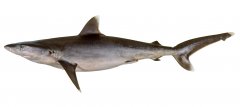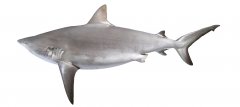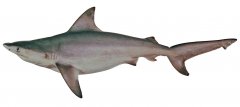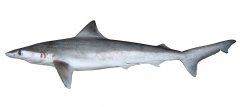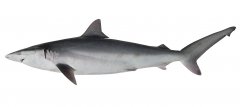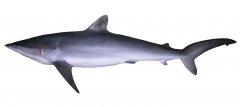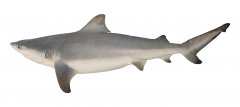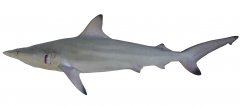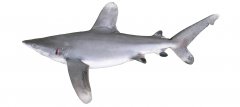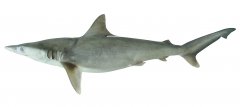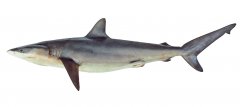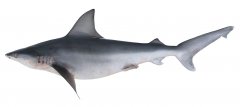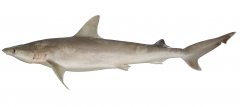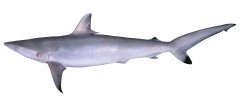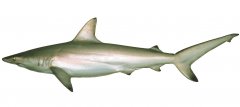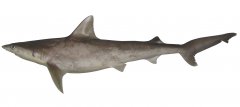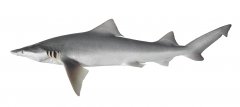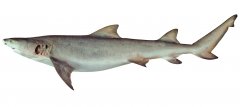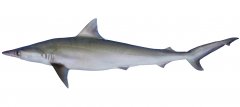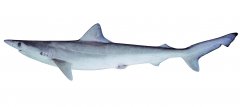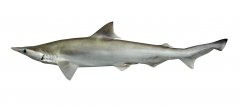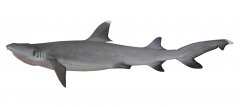All keys adapted from Compagno & Niem, 2001.1
-
- Strong cusplets on most teeth in both jaws (Fig. 1); expanded nasal flaps forming a tube for the excurrent aperture (Fig. 2a) Triaenodon obesus
- Cusplets low or absent on upper teeth, usually absent on lower teeth; nasal flaps not forming a tube (Fig. 2b) 2
-
- Snout short, preoral length much less than mouth width (Fig. 4a); upper and lower teeth with narrow, unserrated cusps (Fig. 5a) Negaprion acutidens
- Snout longer, preoral length about equal to mouth width (Fig. 4b); upper teeth with broadly triangular, serrated cusps (Fig. 5b) Lamiopsis tephrodes
-
- Head greatly depressed and trowel-shaped (Fig. 6); pectoral fins broadly triangular, length about equal to anterior margin (Fig. 7a); first dorsal-fin free rear tip about over midbases of pelvic fins (Fig. 8a); posterior margin of caudal fin only shallowly concave (Fig. 9a) Scoliodon macrorhynchos
- Head conical to slightly depressed; pectoral fins narrow, length less than anterior margin (Fig. 7b); first dorsal-fin free rear tip over or anterior to pelvic-fin origins (Fig. 8b); posterior margin of caudal fin deeply incised (Fig. 9b) 5
-
- Second dorsal-fin origin about level with or slightly anterior to anal-fin insertion (Fig. 10a); preanal ridges very distinct and long, about as long or longer than length of anal-fin base (Fig. 11a); posterior margin of anal fin straight or shallowly concave (Fig. 12a) 6
- Second dorsal-fin origin usually level with anal-fin origin (Fig. 10b), or in some species about level with midbase of anal fin (Fig. 10c); preanal ridges short, up to only half length of anal-fin base (Fig. 11b); posterior margin of anal fin deeply concave or deeply notched (Fig. 12b) 7
-
- Posterior notches present on eyes (Fig. 13a) first dorsal-fin base 2 to 3 times in distance between pectoral and pelvic fin bases (Fig. 14a) Loxodon macrorhinus
- No notches on eyes (Fig. 13b); first dorsal-fin base usually less than 2 times in distance between pectoral and pelvic fin bases (Fig. 14b) (up to 2 times in adult R. acutus) Rhizoprionodon species
-
- A weak lateral keel present on each side of caudal peduncle (Fig. 15); first dorsal-fin base much closer to pelvic- than to pectoral-fin bases (Fig. 16a) papillose gill rakers present on gill arches (Fig. 17a); upper surfaces brilliant dark blue Prionace glauca
- No lateral keels on caudal peduncle; first dorsal-fin base midway between pectoral- and pelvic-fin bases (Fig. 16b); no papillose gill rakers on gill arches (Fig. 17b); upper surfaces greyish, brownish to greyish black 8
-
- Precaudal pits longitudinal and relatively shallow (Fig. 18a); second dorsal fin 1/2 height of first dorsal fin (Fig. 19a) Glyphis gangeticus
- Precaudal pits transverse, deep and crescentic (Fig. 18b); second dorsal fin 2/5 or less height of first dorsal fin (Fig. 19b) Carcharhinus species
-
- Upper labial furrows long and prominent, 1.4–2.0% of TL (Fig. 1a); teeth numerous, usually 25 upper rows and 24 lower rows Rhizoprionodon acutus
- Upper labial furrows short and inconspicuous, less than 1% of TL (rarely up to 1.3% TL), uppers usually shorter than lowers (Fig. 1b); teeth less numerous, 23–25 upper rows and 21–24 lower rows 2
-
- 7–16 enlarged hyomandibular pores just behind mouth corners in total from both sides of head (Fig. 2a); precaudal vertebrae 84–91 Rhizoprionodon oligolinx
- 15–22 enlarged hyomandibular pores just behind mouth corners in total from both sides of head (Fig. 2b); precaudal vertebrae 73–80 Rhizoprionodon taylori
-
- First dorsal and pectoral fins very broad distally with broadly rounded tips, only tapering slightly toward their tips (Fig. 1a); most fin tips mottled white in adults (juveniles with black-tipped fins and a black dorsal saddle on caudal peduncle) Carcharhinus longimanus
- First dorsal and pectoral fins tapering towards pointed or narrowly rounded tips (Fig. 1b); fin not mottled white in adults, often black-tipped but never with a black saddle on caudal peduncle 2
-
- First dorsal, pectoral, pelvic, and caudal fins with extremely conspicuous white tips and posterior edges Carcharhinus albimarginatus
- Fins not conspicuously tipped and edged with white (although some C. amblyrhynchos have a white-tipped first dorsal fin) 3
-
- First dorsal fin falcate (Fig. 2a); snout not flattened, rounded in dorsal view; precaudal vertebral centra 153–160 Carcharhinus sealei
- First dorsal fin triangular, not falcate (except in some juveniles) (Fig 2b); snout slightly flattened, somewhat pointed in dorsal view; precaudal vertebral centra 113–129 Carcharhinus tjutjot
-
- Caudal fin prominently black-edged along entire posterior margin (Fig. 3a); first dorsal fin plain or white-tipped, never black-tipped Carcharhinus amblyrhynchos
- Caudal fin either plain or narrowly black-edged, but if black-edged first dorsal fin also prominently black-tipped 6
-
- Second dorsal fin, pectoral fin, and ventral caudal-fin lobe strikingly black-tipped Carcharhinus sorrah
- Fins plain or dusky-tipped but not strongly black-tipped 8
-
- First dorsal-fin origin well behind free rear tips of pectoral fins (Fig. 5a); inner margin of second dorsal fin very long, usually over twice (but rarely down to 1.6) times fin height (Fig. 6a); very coarse serrations or small cusplets on base of upper anterolateral teeth (Fig. 7a) Carcharhinus falciformis
- First dorsal-fin origin over or anterior to free rear tips of pectoral fins (Fig. 5b) inner margin of second dorsal fin shorter and generally less than twice fin height (but up to 2.1 times fin height in C. obscurus) (Fig. 6b); serrations on feet of upper anterolateral teeth small and not very coarse (Fig. 7b) 9
-
- First dorsal-fin origin opposite or somewhat in front of free rear tips of pectoral fin but closer to them than pectoral-fin insertions (Fig 8a) Carcharhinus obscurus
- First dorsal-fin origin in front or over pectoral-fin insertions or at least closer to insertions than to free rear tips of pectoral fins (Fig. 8b) 10
-
- First dorsal fin very high (except in newborn individuals), its height about 1/2 of predorsal length (Fig. 9a); distance from nostrils to mouth more than 2.4 times in mouth width (Fig. 10a); upper anterolateral teeth moderately high, usually in 14 rows Carcharhinus plumbeus
- First dorsal fin lower, its height much less than 1/2 of predorsal length (Fig. 9b); distance from nostrils to mouth less than 2.4 times in mouth width (Fig. 10b); upper anterolateral teeth very high, usually in 15 rows Carcharhinus altimus
-
- Entire posterior margin of caudal fin with a narrow but obvious black edge (Fig 11); pectoral, second dorsal, and caudal fins with obvious black tips; first dorsal fin with a broad black blotch at its apex, highlighted below with white (Fig. 12) Carcharhinus melanopterus
- Posterior margin of caudal fin not black or only partly dusky or blackish; fins black-tipped or not; first dorsal fin, if black-tipped, not broadly black-tipped 12
-
- Snout very short and broadly rounded (Fig. 13a); upper anterolateral teeth with very broad, triangular cusps and straight to concave distal margins; lower anterolateral teeth with strongly arched roots (Fig. 14a) 13
- Snout longer and parabolic or wedge-shaped to pointed (Fig. 13b); upper anterolateral teeth with narrow cusps and strongly notched distal margins; lower anterolateral teeth with nearly straight roots (Fig. 14b) 14
-
- First dorsal-fin height more than 3.1 times second dorsal-fin height (Fig. 15a); angle of notch in anal-fin posterior margin more acute, usually less than a right angle (Fig. 16a); usually 11 lower anteroposterior teeth, with extremely broad cusps (Fig. 17a); precaudal centra 89–95 Carcharhinus amboinensis
- First dorsal-fin height less than 3.1 times the second dorsal-fin height (Fig. 15b); angle of notch in anal-fin posterior margin more obtuse, usually a right angle or more (Fig. 16b); usually 12 lower anteroposterior teeth, with moderately broad cusps (Fig. 17b); precaudal centra 101–123 Carcharhinus leucas
-
- Second dorsal-fin origin well behind anal-fin origin, about level with its midbase (Fig. 18a) 15
- Second dorsal-fin origin about level with anal-fin origin (Fig. 18b) 16
-
- Rostrum expanded as a hypercalcified, hardened mass, easily detected by pinching or cutting into the snout; upper anterolateral teeth with large mesial and distal cusplets and no serrations (Fig. 19a); no enlarged pores alongside mouth corners (Fig. 20a) Carcharhinus macloti
- Rostrum not hypercalcified; upper anterolateral teeth with distal cusplets and serrations (Fig. 19b); hyomandibular pores conspicuously enlarged alongside mouth corners (Fig. 20) Carcharhinus borneensis
-
- First dorsal fin relatively low, its height more than 2.2 times in the interdorsal space (Fig. 21a); first dorsal-fin origin over or just behind rear tips of pectoral fins (Fig. 22a); upper labial furrows noticeably elongated and prominent (Fig 23a); usually at least 16 rows of upper anteroposterior teeth Carcharhinus brevipinna
- First dorsal fin higher, its height 2.2 times or less in interdorsal space (Fig. 21b); first dorsal-fin origin over or just behind insertions of pectoral fins (Fig. 22b); upper labial furrows shorter and less noticeable (Fig. 23b); usually 15 or less rows of upper anteroposterior teeth 17
-
- Snout rather short and wedge-shaped, internarial space 1.0–1.2 times in preoral snout (Fig. 24a); second dorsal height 1.0–1.2 times in inner margin length (Fig. 25a) Carcharhinus amblyrhynchoides
- Snout relatively long and pointed, internarial space 1.3–1.7 times in preoral snout (Fig. 24b); second dorsal height 1.1–1.6 times in inner margin length (Fig. 25b) 18
-
- Pelvic fins with distinct black tips on ventral surface (Fig. 26a); precaudal centra 88–109 Carcharhinus limbatus
- Pelvic fins plain or with dusky tips on ventral surface (if black-tipped, less than 1% of fin area black) (Fig 26b); precaudal centra 82–91 Carcharhinus tilstoni
Lamnidae
Mackerel sharks
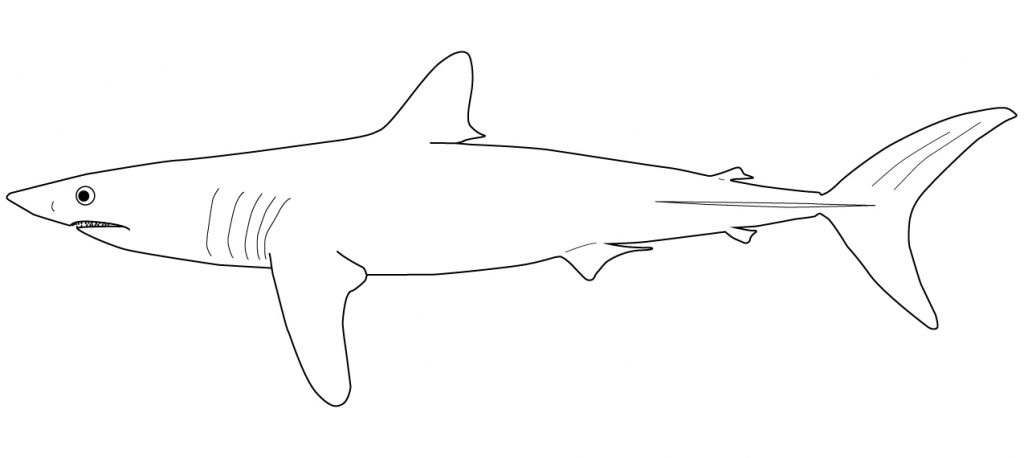
Lamnidae differ in having no nictitating lower eyelids (vs. well-developed nictitating lower eyelids); caudal fin lunate and near symmetrical, upper and lower lobes of similar length (vs. strongly asymmetrical caudal fin with the upper lobe longer than the lower); a caudal peduncle strongly depressed dorsoventrally and expanded laterally (vs. caudal peduncle not greatly flattened dorsoventrally); longitudinal keels prominent, extending well out from peduncle (vs. weak in Prionace glauca or absent) and intestinal valve ring type (vs. scroll type).
Galeocerdidae
Tiger shark

Galeocerdidae differs in having sides usually with dark, wavy, broken vertical bars, although absent in large adults (vs. body colouration usually plain, sometimes with a pale or white stripe along sides); prominent keels on caudal peduncle (vs. weak in Prionace glauca or absent); labial furrows around mouth very long and prominent (vs. short or absent) and a spiracle present above eyes (vs. spiracle absent).
- Compagno L, Niem V. Carcharhinidae. In: Carpenter K, Niem V, (eds) FAO Species Identification Guide for Fishery Purposes. The Living Marine Resources of the Western Central Pacific. Volume 2. Cephalopods, Crustaceans, Holothurians and Sharks. Vol 2. Rome: FAO Library; 2001:1312-1360. http://www.fao.org/3/w7192e/w7192e00.htm.
